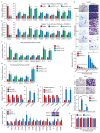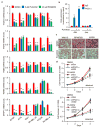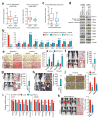A PGC1α-mediated transcriptional axis suppresses melanoma metastasis
- PMID: 27580028
- PMCID: PMC5161587
- DOI: 10.1038/nature19347
A PGC1α-mediated transcriptional axis suppresses melanoma metastasis
Abstract
Melanoma is the deadliest form of commonly encountered skin cancer because of its rapid progression towards metastasis. Although metabolic reprogramming is tightly associated with tumour progression, the effect of metabolic regulatory circuits on metastatic processes is poorly understood. PGC1α is a transcriptional coactivator that promotes mitochondrial biogenesis, protects against oxidative stress and reprograms melanoma metabolism to influence drug sensitivity and survival. Here, we provide data indicating that PGC1α suppresses melanoma metastasis, acting through a pathway distinct from that of its bioenergetic functions. Elevated PGC1α expression inversely correlates with vertical growth in human melanoma specimens. PGC1α silencing makes poorly metastatic melanoma cells highly invasive and, conversely, PGC1α reconstitution suppresses metastasis. Within populations of melanoma cells, there is a marked heterogeneity in PGC1α levels, which predicts their inherent high or low metastatic capacity. Mechanistically, PGC1α directly increases transcription of ID2, which in turn binds to and inactivates the transcription factor TCF4. Inactive TCF4 causes downregulation of metastasis-related genes, including integrins that are known to influence invasion and metastasis. Inhibition of BRAFV600E using vemurafenib, independently of its cytostatic effects, suppresses metastasis by acting on the PGC1α-ID2-TCF4-integrin axis. Together, our findings reveal that PGC1α maintains mitochondrial energetic metabolism and suppresses metastasis through direct regulation of parallel acting transcriptional programs. Consequently, components of these circuits define new therapeutic opportunities that may help to curb melanoma metastasis.
Conflict of interest statement
The authors disclose no potential conflicts of interest. Author Information The authors declare no competing financial interests. Readers are welcome to comment on the online version of the paper.
Figures













Comment in
-
Decision to grow or to invade is at the flick of metabolic switch, PGC1α.Pigment Cell Melanoma Res. 2017 Mar;30(2):179-180. doi: 10.1111/pcmr.12558. Epub 2017 Mar 6. Pigment Cell Melanoma Res. 2017. PMID: 27863025 No abstract available.
Similar articles
-
H3K27me3-mediated PGC1α gene silencing promotes melanoma invasion through WNT5A and YAP.J Clin Invest. 2020 Feb 3;130(2):853-862. doi: 10.1172/JCI130038. J Clin Invest. 2020. PMID: 31929186 Free PMC article.
-
ERRα Maintains Mitochondrial Oxidative Metabolism and Constitutes an Actionable Target in PGC1α-Elevated Melanomas.Mol Cancer Res. 2017 Oct;15(10):1366-1375. doi: 10.1158/1541-7786.MCR-17-0143. Epub 2017 Jun 8. Mol Cancer Res. 2017. PMID: 28596418 Free PMC article.
-
Oncogenic BRAF regulates oxidative metabolism via PGC1α and MITF.Cancer Cell. 2013 Mar 18;23(3):302-15. doi: 10.1016/j.ccr.2013.02.003. Epub 2013 Mar 7. Cancer Cell. 2013. PMID: 23477830 Free PMC article.
-
The Novel Role of PGC1α in Bone Metabolism.Int J Mol Sci. 2021 Apr 28;22(9):4670. doi: 10.3390/ijms22094670. Int J Mol Sci. 2021. PMID: 33925111 Free PMC article. Review.
-
The Role of PGC1α in Cancer Metabolism and its Therapeutic Implications.Mol Cancer Ther. 2016 May;15(5):774-82. doi: 10.1158/1535-7163.MCT-15-0621. Epub 2016 Apr 15. Mol Cancer Ther. 2016. PMID: 27197257 Review.
Cited by
-
Transforming growth factor-β downregulates sGC subunit expression in pulmonary artery smooth muscle cells via MEK and ERK signaling.Am J Physiol Lung Cell Mol Physiol. 2019 Jan 1;316(1):L20-L34. doi: 10.1152/ajplung.00319.2018. Epub 2018 Sep 27. Am J Physiol Lung Cell Mol Physiol. 2019. PMID: 30260287 Free PMC article.
-
N6-methyladenosine demethylase FTO suppresses clear cell renal cell carcinoma through a novel FTO-PGC-1α signalling axis.J Cell Mol Med. 2019 Mar;23(3):2163-2173. doi: 10.1111/jcmm.14128. Epub 2019 Jan 16. J Cell Mol Med. 2019. PMID: 30648791 Free PMC article.
-
Novel prognostic model predicts overall survival in colon cancer based on RNA splicing regulation gene expression.Cancer Sci. 2022 Oct;113(10):3330-3346. doi: 10.1111/cas.15480. Epub 2022 Aug 16. Cancer Sci. 2022. PMID: 35792657 Free PMC article.
-
PGC1α-Mediated Metabolic Reprogramming Drives the Stemness of Pancreatic Precursor Lesions.Clin Cancer Res. 2021 Oct 1;27(19):5415-5429. doi: 10.1158/1078-0432.CCR-20-5020. Clin Cancer Res. 2021. PMID: 34172498 Free PMC article.
-
The TGF-β/HDAC7 axis suppresses TCA cycle metabolism in renal cancer.JCI Insight. 2021 Nov 22;6(22):e148438. doi: 10.1172/jci.insight.148438. JCI Insight. 2021. PMID: 34609963 Free PMC article.
References
-
- Puigserver P, Spiegelman BM. Peroxisome proliferator-activated receptor-gamma coactivator 1 alpha (PGC-1 alpha): transcriptional coactivator and metabolic regulator. Endocr Rev. 2003;24:78–90. - PubMed
MeSH terms
Substances
Grants and funding
LinkOut - more resources
Full Text Sources
Other Literature Sources
Medical
Research Materials

